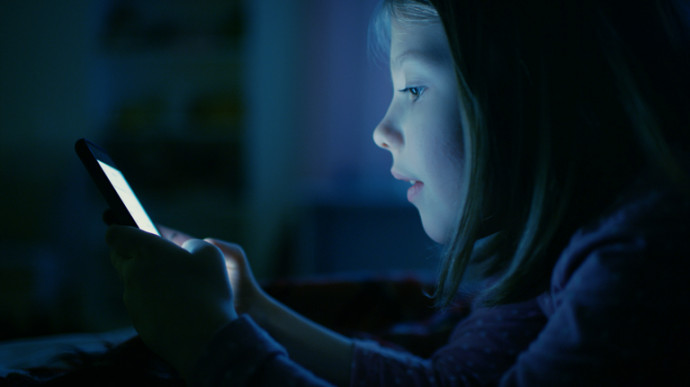News
Published 13 November 2018Perpetual jetlag? Exposure to artificial blue light a risk in Aotearoa

Media release: A new paper released today by Royal Society Te Apārangi finds that our increasing exposure to artificial blue light is a possible risk for our health, for wildlife and for studying the night sky. However, there are many things we can do to protect ourselves and te taiao the environment from artificial blue light.
The paper Blue Light Aotearoa summarises the latest research evidence on this topic. Royal Society Te Apārangi President Professor Wendy Larner FRSNZ says there is growing concern about potential health problems from people being exposed to blue light from artificial lights and screens at night. “We wanted to pull together all the evidence about what is known, not only for human health, hauora, but also on the wider impact on wildlife. The paper also looks at how artificial lights can disrupt our ability to see the night sky and our ability to learn more about our universe through astronomy.”
Blue light is a part of the visible electromagnetic spectrum. It is part of daylight and peaks at the middle of the day. The orange glow we see at sunrise and sunset is due to less blue light wavelengths reaching us. Different types of artificial lights and screens emit varying amounts of blue light.
In 2002 scientists discovered a new type of cell in the human eye that detects blue light. Unlike the rod and cone cells in our eye that allow us to see, these cells send signals to the part of the brain that is the time keeper for our internal rhythms, such as when we feel sleepy or hungry or when different hormones are produced.
Dr Lora Wu, Senior Research Officer at Massey University’s Sleep/Wake Research Centre and a contributor to the report, says many people have experienced having their body clock out of whack with the day-night cycle: jetlag. “These blue-light sensitive cells in our eyes reset our body clock to the new time zone when we travel, but if these cells perceive too much blue light at night, then our body gets the wrong message about what time of day it is. This not only disrupts our sleep but can have a range of negative flow-on effects to our health, such as increased risk of obesity, depression and potentially some types of cancer. New evidence for health problems caused from disrupted sleep is emerging all the time.”
On the other hand, people need to be exposed to blue light in the morning to keep their body clock in sync. The message can be summed up with a little ditty ‘Blue light at night, not so bright, blue light in the morning, stops you yawning…’
“What we’re saying is people need to be exposed to blue light during the day, particularly in the morning, to keep their internal body clock in sync with the actual light-dark cycle. The best way of receiving this light is by being outside or via strong natural light coming in through a window. But, at the other end of the day, we need to limit how much blue light we are exposed to so as to not disrupt our sleep cycle and the many other factors of metabolism that are associated with our body clock, like digestion and cell renewal.”
Rather than sitting in the dark, there are practical things we can do to reduce our exposure to blue light at night, Dr Wu says.
“Inside our homes we can replace bluer ‘cooler’ light bulbs to bulbs that emit more yellow ‘warm’ light and use dimmers. We can also use software that reduces bright blue light from our digital screens at night or turn them off. It’s also important to make sure your bedroom is dark while you sleep, so unplug any ‘glowing’ devices and use good quality curtains.”
It’s not just humans who are affected by artificial blue light. Plants and animals also possess body clocks that regulate their rhythms of activity throughout the day and across the seasons. Exposure to artificial light can disrupt their body clocks and affect pollination, feeding behaviours and reproduction.
Blue wavelength light is more strongly scattered by the night sky, increasing skyglow if the lights are left unshielded.
Associate Professor Karen Pollard, Director of the University of Canterbury Mt John Observatory and a contributor to the report, says that any increase in sky brightness has implications for making astronomical observations. “We need dark skies to be able to detect the faint lights from objects in outer space.”
She says one way to protect wildlife and our ability to study the night sky is to set up Dark Sky reserves to reduce light pollution.
Aoraki Mackenzie International Dark Sky Reserve around Tekapo recently won the 2018 Dark Sky Place of the Year from the International Dark Sky Association, being recognised as a world leader for protecting dark night skies and communicating the value and fragility of this resource to the public. It was designated New Zealand’s first International Dark Sky Place in 2012. Former Mt John Observatory Director John Hearnshaw FRSNZ, who also contributed to the report, is travelling to the US to receive the award this month.
Associate Professor Pollard says that Great Barrier Island received Dark Sky Sanctuary certification in 2017 and work is underway for Martinborough to become a Dark Sky Reserve and Stewart Island, Waiheke Island and Naseby to also become Dark Sky Places.
“It’s heartening to see this positive action towards reducing light pollution in Aotearoa. Outside these areas, people are talking about how we can best light roads and urban spaces – finding win-win solutions where we have the light we need to move about safely without increasing other risks to human health, wildlife or the visibility of our night sky. The technology exists now or will soon exist for us to achieve this balance.”
Resources on impacts of artificial blue light are available at royalsociety.org.nz/bluelight
